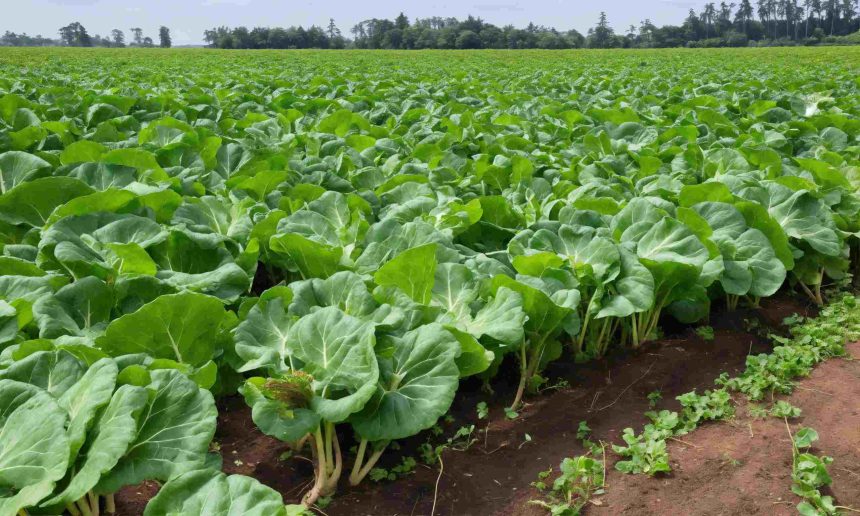Watermelons are a fun, tasty summer fruit that can be grown in many home gardens. While watermelons mainly need plenty of sun, water and good soil to thrive, interplanting them with strategic companion plants can help them grow even bigger and become sweeter, healthier fruits.
What are Watermelon Companion Plants?
Watermelon companion plants are other fruits, vegetables, herbs or flowers that create beneficial growing conditions for watermelons when interplanted near them.
The companions can:
- Attract more pollinators like bees to ensure thorough pollination and full fruit set
- Deter or distract pests, protecting watermelons from damage
- Enhance flavor and sweetness through symbiotic root interactions
- Improve soil nutrition and water retention
- Provide structural support for watermelon vines and fruits
Carefully choosing the right accompanying plants allows the gardener to optimize the soil ecology and growing environment around watermelon plants specifically.
Benefits Companion Plants Offer to Watermelons

Interplanting watermelon vines with strategic companion plants offers a variety of advantages:
Enhanced Pollination
Like all cucurbits, watermelons have both male and female blossoms that require pollen transfer for fertilization and fruit production. Companions that attract pollinators like bees and butterflies can greatly improve pollination.
Good companion plants for this include:
- Flowering herbs like borage, bee balm, basil
- Flowering vegetables like peppers and squash
- Cosmos, zinnias, marigolds and other flowering annuals
- Sunflowers!
Pest Control
Cucurbits like watermelons are prone to heavy pest damage from cucumber beetles, squash vine borers, squash bugs and more. Border plants and beneficial insect-attracting flowers can provide a protective buffer.
Effective pest-fighting companions include:
- Radishes, nasturtiums and marigolds deter certain pests
- Dill, fennel, cilantro attract predatory wasps that parasitize eggs
- Onions, chives, garlic and other alliums repel aphids and beetles
Enriched Soil Nutrition
The extensive watermelon root system forms symbiotic relationships with certain plants in return for soil nutrients delivered by fungal networks.
Nutrient accumulators like:
- Beans
- Peanuts
- Cowpeas
Can gather nitrogen and phosphorus from the soil and feed it to entwined watermelon roots.
Moisture Retention
Some companion plants help retain moisture and regulate soil temperature. This is especially helpful for watermelons, which need consistent water availability through their long growing season.
Useful moisture-conserving companion plants include:
- Straw mulch
- Living mulches like clover and alfalfa
- Corn and sunflowers, which provide shade and protection
Space Efficiency
Vining watermelon plants take up significant garden space. Interplanting with low-growing companions that occupy a different height layer maximizes yield in smaller plots.
Good space-saving companion plant matches include:
- Bush beans
- Radishes
- Low herbs like thyme and chamomile
- Early harvested vegetables like lettuce and spinach
Structural Support
As fruits swell, watermelon vines can drag on the soil and break off the plant. Companions with sturdy stems offer natural trellising for vines to grow upon.
Some great structural support companions:
- Corn
- Sunflowers
- Poles beans
- Tomato cages
Best Overall Companion Plants for Watermelons

While many different fruits, flowers and vegetables make excellent watermelon companions, a few really stand out when interplanted near watermelons.
Corn
Growing corn with watermelons is one of the most classic and mutually beneficial companion pairings. As natural climbing supports, corn stalks allow watermelon vines to grow vertically off the ground. Tall corn plants also provide needed shade and insect protection.
In return, watermelon vines control weeds and retain moisture around corn roots. As legumes, they may supply nitrogen to corn as well. A very space efficient match!
Beans
Snap peas, pole beans and bush beans all make great matches with watermelon vines. As nitrogen fixers, they actively accumulate and supply nitrogen from the air into the soil for watermelons. Shallow bean roots contrast with the deep watermelon roots as well, reducing competition.
Beans also can climb corn and sunflower stalks alongside watermelons. Together they make a very protein-rich polyculture.
Radishes
Quick-growing radishes mature long before watermelons, making them ideal time-stacked companions. Their pungent scent deters cucumber beetles while their roots break up and aerate soil. Radish flowers also attract pollinators in early summer to benefit early watermelon blooms.
Once pulled, radishes leave open pockets of loosened soil and nutrients right where melon vines can take advantage. A great multi-functional living mulch!
Marigolds
Pretty marigolds aren’t just showy annuals. They exude chemical compounds from their roots that deter nematodes, soil-dwelling insects and certain weed species – all of which can disrupt watermelon growth and health.
Different marigold varieties can be planted densely around melon mounds, interspersed through vines or dotted along borders. Their bright blossoms also attract aphid-eating ladybugs.
Companion Planting Tips for Watermelons

When interplanting watermelon vines with beneficial friends, keep these companion planting tips in mind:
Give Vines Sufficient Room
Even with structural supports, watermelon vines need adequate lateral space to expand across the bed. Leave at least 2 feet between mounds for runners.
Match Crop Maturity Times
Fast-growing companions like cool weather greens, radishes and quick beans work well, as they mature and free up growing room before thirsty watermelon fruits swell to full size.
Use Vertical Space
Structural companions like taller corn, sunflower and pole bean teepees allow compatible vining plants to grow up instead of out.
Use Proper Crop Rotations
Avoid planting watermelons and companions where cucurbits, corn or nightshades grew last year to prevent disease carryover.
Allow for Shade Tolerance
Not all companion plants tolerate partial shade well. Adjust plant densities to prevent excessive shading of sun-loving companions.
Give Pollinators Access
Space flowers both within and around vines so beneficial insects can maneuver easily to reach and transfer pollen between them.
10 Winning Watermelon Companion Planting Combinations

Based on all their mutually beneficial strengths, here are 10 interplant schemes guaranteed to grow bigger, healthier watermelons!
1. The Classic: Watermelons, Corn & Beans
This Native American interplanting trio offers the full package deal: corn stalks for vines to climb, beans to fix nitrogen and plenty of shade. Add some radishes or marigolds guarding melon mounds and you have the perfect watermelon companion system!
2. Watermelons & Sunflowers
Giant sunflower stalks serve double duty as in-ground trellises and living shade umbrellas. As extensive root systems gather nutrients, blooming sunflower heads attract clouds of pollinators to benefit both species through symbiotic relationships.
3. The Flower Power Combo: Watermelons, Cosmos, Marigolds & Zinnias
Ring watermelon hills with lots of pollinator-magnet flowers like vibrant cosmos, aromatic marigolds and cheery zinnias. The showy annuals will beautify your garden all summer while improving melon pollination and pest protection too.
4. Watermelons & Radishes
Quick growing daikon and Champion radishes will deter pest insects and improve soil conditions for watermelons. Once pulled, they leave open pockets of space and nutrients for vines to infiltrate the perfect living mulch!
5. The Seeded Shield: Watermelons, Cucumbers & Pumpkins
Interplant seeded melons together with vining cucumbers and disease-resistant pumpkins. As cucurbit relatives, they make compatible bedmates. Planted around the perimeter, the fruits shield inner watermelons while attracting pollinators and confusing specialist pests.
6. Watermelon, Sweet Potatoes & Pole Beans
Here’s an awesome late summer polyculture: sweet potatoes fill space underground as beans climb corn stalks above. By summer’s end, melons have room to vine out. Beneficial mycorrhizal fungi connect the roots in a true plant community!
7. Watermelon, Tomatoes & Basil
Tomatoes thrive alongside watermelon vines much like their relative, cucumber plants. Grow rainbow cherry tomatoes up teepees with sweet basil lining sunny melon mounds. The aromatic herb deters pests while the colorful cocktail tomatoes draw pollinators.
8. Living Mulch: Watermelon & White Clover
Instead of plastic, plant a healthy ground cover of bee-friendly white clover instead. As a living mulch around melon mounds, clover fixes extra nitrogen, improves soil, retains moisture and doesn’t impede vines. The perfect perennial plant partner!
9. An Herbal Haven: Watermelon, Dill, Chamomile & Garlic Chives
Here’s an amazing herbal haven: green coils of dill attract predatory wasps while garlic chives mask melon’s scent from pests. Flowery Roman chamomile makes a lovely (and edible!) aesthetic and insectary ground cover living mulch. It smells heavenly too!
10. Fungal Friends: Watermelon, Peanuts & Cowpeas
The extensive roots of peanuts and cowpeas foster abundant mycorrhizal fungi below ground that forge connections with watermelon roots. Through this energy exchange, melons upregulate nutrient intake and improve stress resistance. Stronger fungal allies mean bigger, healthier fruits!
Caring for Watermelon Plants

Watermelons are a delicious, fun fruit to grow in the summer garden. However, caring for watermelon plants does require some specific considerations to help the vines thrive and produce abundant sweet fruits. Follow this complete watermelon care guide for the best harvest yet!
Choosing the Best Varieties
There are over 50 popular watermelon varieties to select from. Important traits to look for include:
- Mature size – Compact “icebox” types for small spaces vs larger oblong or round melons
- Days to maturity – Choose quick Tendersweet types or full season varieties based on your growing season length
- Seed type – Seeded melons have more flavor but seedless are very convenient
- Fruit color – Classic green rinds or specialty orange, yellow or white flesh colors
- Sweetness – Sugar Baby and Sweet Sensation live up to their names!
Some top-rated seeded and seedless varieties include: Sugar Baby, Black Diamond, Crimson Sweet, Orangeglo, Mickylee and Tendersweet.
Sun and Soil Requirements
As tropical vines, watermelons need:
- Full sun – At least 6+ hours of direct sunlight daily
- Well-draining soil – Sandy loams or clay enriched with compost
- Neutral pH – Ideal range is between 6.0 – 6.8
Ideally choose a sheltered, south-facing position protected from wind. Prior to planting, turn over beds thoroughly and remove all weeds.
Planting Tips
- When to plant – After all danger of frost when soils reach 65°F
- How to plant – Sow 3-4 seeds together 1” deep in hills or raised mounds spaced 2’ apart
- Row spacing – Leave 5-6’ between rows depending on variety size
- Companion plants – Interplant with radishes, corn or pole beans
Use row covers, cold frames or greenhouse starts 1-2 weeks before last expected frost to get a head start on the season.
Water and Feeding
Consistent moisture is key, especially when fruits start swelling. Provide:
- 1-2” of water per week from irrigation or rainfall
- Use drip lines, soaker hoses or hand watering to keep foliage dry
- Side dress vines once blooming with balanced organic vegetable fertilizer
Use pest and disease prevention tips to avoid blossom end rot from inconsistent watering as well.
Pollination
Male and female watermelon blossoms grow separately on the same vines. For fruit production, the flowers must receive pollen from bees visiting multiple blooms.
Support thorough pollination by:
- Planting bee-attracting companion flowers
- Avoiding pesticide use during flowering period
- Gently shaking vines on still days to disperse pollen
Hand pollination is also an option if needed.
Vine Care and Training
Watermelon vines can extend over 20 feet! Train them properly by:
- Pinching side shoots for 2-3 main stems
- Weaving and securing expanding vines to trellises or frames
- Providing row cover tunnels to keep foliage clean and dry
- Turning overrun fruits resting on soil to prevent rot
Harvesting Perfectly Ripe Watermelons
It takes around 90 days for watermelons to finish ripening. Check for these tell-tale signs:
- Yellow bottom spot where melon touches soil
- Curly tendril nearest fruit dries and browns
- Rind texture changes from shiny to dull
- Sound is hollow when thumped vs unripe solid sound
Use a sharp knife to cut melons from vines, leaving 2-3” of stem attached. Wash and store freshly picked melons for up to 2-3 weeks.
Preventing and Managing Pests and Diseases

Growing lush, sweet watermelons requires careful monitoring to avoid attacks from common insects, animals and fungal or bacterial diseases. Learn how to prevent and manage the most common watermelon pests and diseases for the healthiest fruits possible.
Most Troublesome Watermelon Pests
Several insects target watermelons during the long growing season. Be on the lookout for these common pests:
Cucumber Beetles
Striped and spotted beetles transmit bacterial wilt disease as they feed on vines and leaves. Cover young plants with floating row covers to exclude the beetles. Handpick any spotted and immerse vines around damaged areas in insecticidal soap.
Squash Vine Borers
Reddish larvae tunnel and feed inside main vines, causing wilting and plant death. Slit damaged vines lengthwise and remove borers, then bury stems with soil to regenerate roots. Prevent infestations by applying parasitic nematodes early on.
Squash Bugs
These dark grey insects suck nutrients from leaves, causing wilt. Check undersides of leaves for clusters of red-brown eggs and remove. Apply lightweight horticulture oil or neem oil to suffocate adults and nymphs on contact.
Melon Aphids
Dense white or green colonies cluster on leaves and vines, stunting plants and transmitting viral diseases. Blast aphids off foliage with strong jets of water and treat plants with insecticidal soap weekly to keep populations under control.
Most Common Watermelon Diseases
Waterlogged or humid conditions promote fungal and bacterial diseases:
Anthracnose
Identify this fungal disease by round, water-soaked lesions on ripening fruits. Avoid overhead watering and provide good drainage and air circulation. Remove and destroy infected fruits and treat vines with copper fungicide as prevention.
Fusarium Wilt
Leaves rapidly yellow and wilt as vascular tissues are damaged by this soil-borne fungus. Use wilt-resistant varieties, crop rotation, soil solarization and cover crops to manage it without fungicides.
Bacterial Fruit Blotch
Small water-filled lesions form on fruits, expanding into sunken rot. Only plant resistant varieties and practice 3+ year crop rotations to limit this bacterial infection.
Alternaria Leaf Spot
Zones of dark dots on older foliage expanding into yellow lesions signals this fungal disease. Improve airflow while spraying neem oil or potassium bicarbonate weekly as both treatment and prevention.
FAQs
Watermelons thrive in light, well-draining loam soil with high organic matter content. Amend clay soils with compost or peat; add garden sand or wood chips to retain moisture in fast-draining soils. Soil pH should be between 6.0 – 6.8.
You can start watermelon transplants indoors 3-4 weeks before your last expected spring frost date. Sow seeds in individual biodegradable pots to avoid disturbing roots during transplanting outside into garden beds once day and night temperatures remain above 60°F.
As a sprawling summer vine crop, watermelons need lots of garden space! Leave at least 2 feet between planting mounds in rows spaced 5-6 feet apart. Smaller “icebox” melon varieties require slightly less room. Be sure to account for watermelon size based on variety and provide structural supports for vines.
Watermelons have deep root systems but require consistent moisture in the top 6 inches of soil. About 1-2 inches of water per week from rain or irrigation is ideal. Use soaker hoses or drip irrigation and avoid overhead watering to keep foliage dry and prevent disease.
Female and male watermelon blossoms bloom separately on vines. Lack of pollination happens if populations of bees and other pollinating insects are low. Ensure thorough pollination by attracting beneficial pollinators and gently shaking vines on still days to spread pollen. Hand pollination is also an option if needed.
Grow your best watermelons yet!
As you prepare your vegetable garden beds this season, consider interplanting watermelons with compatible, mutually beneficial companion plants selected from this list.
Not only will the strategic combinations improve pollination, limit pest pressure and enrich your soil ecology – they can ultimately help you grow your very best, sweetest watermelons yet!
The symbiotic plant relationships are well worth fostering in home garden spaces of every shape and size through thoughtful companion planting.
Read More
Grow a Thriving Mint Garden with the Right Companion Plants
From Garden to Table: Growing and Crafting Chive Blossom Vinegar




